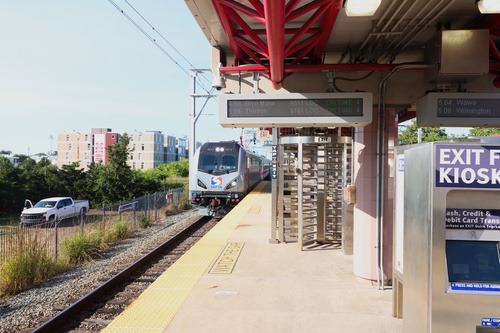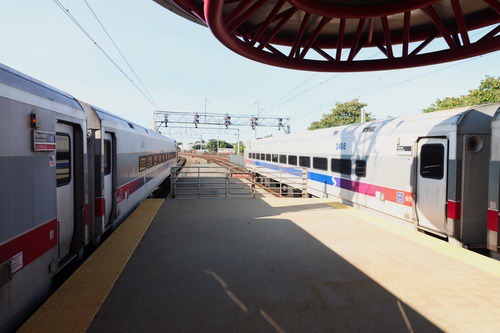


Temple University is the namesake Regional Rail Station for this university (no naming rights here!). It is the first stop on the historic Redding Viaduct after trains leave center city and the modern 1984 Market East Station. The original 1911-built station was the place where the historic viaduct had to be closed just days after the Center City Commuter Connection Opened. Emergency repairs replaced the station temporarily in 1985 with the new and present-day station opening in 1992 as part of SEPTA's RailWorks project that rebuilt the Reading Railroad viaduct through North Philadelphia.
Today the station is the most northern and last stop of the four major Center City stations, although it's just outside of Center City, it is still in the Center City fare zone (although I don't think the free continuing Amtrak travel program applies to this station). The stop today is serviced by nearly all Regional Rail trains on all regional rail lines except all Cynwyd Line trains and weekend Trenton Line trains that terminate at Suburban Station and Market East (Jefferson) Stations respectively. Most Regional Rail trains interline between the ex-Redding Lines and the ex-Pennsylvania Lines. This results in Temple University seeing mostly through trains. A number of trains on the ex-Pennsylvania (which see as a whole higher ridership) Trenton, Chestnut Hill West, Paoli/Thorndale, Media/Wawa, Wilmington/Newark and Airport lines originate or terminate at Temple University and either reverse direction in the station or deadhead to and from the Liberty or Wayne Railyards around the Wayne Junction Station north of Temple station. These yards store the rush hour only push-pull SEPTA trainsets use on expresses, with two entering at Temple University at the same time during the PM rush hour.
The station is entirely set-up as a through train station. There are two modern elevated island platforms for the four-track line. These platforms contain canopies except at their extreme northern ends held up by faux marble supports and red underlying support beams supporting the actual canopies.
The platforms main entrance is at the extreme southern ends of the platforms beyond the ends of the platform. Here a glass block wall blocks access to the outside tracks and a fence blocks access to the inside tracks. There is first a staircase down from each platform these lead down to an intermediate landing just below platform level before joining for a single wider, grand-staircase down to street level. A bit beyond these staircases at the extreme ends of each platform is an elevator down from each platform directly to street level. These elevators arrive at street level tucked back behind the main staircase.
The staircase and elevator lead to an outdoor fare control area nestled under the viaduct at street level, along the north side of Berks Street. To both enter or exit the station passengers must tap their KeyCards at turnstiles (or accessible fare gates). There is no proper station building, just a ticket office in a modular trailer and some SEPTA Key Fare Vending Machines just on the sidewalk.
There is a secondary exit at nearly the northern end of the platforms. Here each platform has two slightly offset High Entrance and Exit Turnstiles (tap to both exit and enter) that lead into a fenced off area that leads a short distance to a staircase down to the south sidewalk of Norris Street where it crosses through the viaduct. These staircases have intermediate landings where they split into two staircases that become parallel to the sidewalk (with the central staircases facing each other at street level).
Photos 1-36: September 3, 2024;

